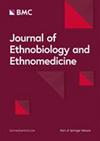Preliminary exploration of herbal tea products based on traditional knowledge and hypotheses concerning herbal tea selection: a case study in Southwest Guizhou, China
IF 2.9
2区 医学
Q1 BIODIVERSITY CONSERVATION
引用次数: 0
Abstract
Herbal tea usually refers to “beverage plants that do not belong to the genus Camellia”, and it holds a significant historical legacy as a traditional beverage among specific regions and ethnic groups. In light of this, our research aims to investigate and analyze the traditional knowledge pertaining to herbal tea plants used by local people in the Qianxinan Buyi and Miao Autonomous Prefecture, Guizhou Province. We also initiated preliminary efforts to create tea products from herbal tea leaves using various processing techniques. Additionally, we attempted to test hypotheses to elucidate how local people select herbal tea plants. Data related to the use of herbal tea plants in this study were collected through semi-structured interviews and participatory observations in four villages in Qianxinan. Quantitative indicators, including the relative frequency of citation (RFC) and the relative importance (RI) value, were calculated, and the availability of plants was also evaluated. General linear model was performed to examine the relationship between the frequency of citation and resource availability, as well as the correlation between the relative frequency of citation and the relative importance, to test both the resource availability hypothesis and the versatility hypothesis. Centella asiatica tea was processed using techniques from green tea, black tea and white tea, with a preliminary sensory evaluation conducted. A total of 114 plant species were documented as being used for herbal teas by local residents, representing 60 families and 104 genera. Of these, 61% of herbal tea plants were found growing in the wild, and 11 species were exotic plants. The family with the highest number of species was Asteraceae (20 species). The study identified 33 major medicinal functions of herbal tea, with clearing heat-toxin and diuresis being the most common functions. General linear model revealed a strong correlation (correlation coefficient of 0.72, p < 0.001) between the frequency of citation and plant availability, as well as a significant correlation (correlation coefficient of 0.63, p < 0.001) between RFC and RI. Under different processing conditions, the characteristics of Centella asiatica tea exhibited variations and were found to be suitable for consumption. The consumption of herbal tea serves as a preventive measure against common ailments for local residents. The resource availability hypothesis, diversification hypothesis and the versatility hypothesis were shown to provide some insight into “how and why local communities select plants for use.” Exotic herbal tea plants in the study area also possess valuable therapeutic properties. The processing and production of Centella asiatica herbal tea products hold promising prospects.基于传统知识的凉茶产品初探及凉茶选择假设:中国黔西南州的案例研究
凉茶通常是指 "不属于山茶属的饮料植物",它作为一种传统饮料在特定地区和民族中有着重要的历史传承。有鉴于此,我们的研究旨在调查和分析贵州省黔西南布依族苗族自治州当地人对凉茶植物的传统认知。我们还初步尝试利用各种加工技术将花草茶叶制成茶产品。此外,我们还尝试验证假设,以阐明当地人如何选择凉茶植物。本研究通过半结构式访谈和参与式观察,在黔西南州的四个村庄收集了与凉茶植物使用相关的数据。研究计算了定量指标,包括相对引用频率(RFC)和相对重要性(RI)值,并评估了植物的可获得性。采用一般线性模型检验了引用频率与资源可得性之间的关系,以及引用相对频率与相对重要性之间的相关性,从而检验了资源可得性假说和多样性假说。采用绿茶、红茶和白茶的工艺对积雪草茶进行了加工,并进行了初步的感官评价。据记载,当地居民用于制作凉茶的植物共有 114 种,代表 60 科 104 属。其中,61%的凉茶植物生长在野外,11 种为外来植物。种类最多的科是菊科(20 种)。研究确定了凉茶的 33 种主要药用功能,其中清热解毒和利尿是最常见的功能。一般线性模型显示,引用频率与植物可用性之间存在很强的相关性(相关系数为 0.72,p < 0.001),RFC 与 RI 之间也存在显著的相关性(相关系数为 0.63,p < 0.001)。在不同的加工条件下,积雪草茶的特性表现出差异,并被发现适合饮用。对当地居民来说,饮用凉茶是预防常见疾病的一种措施。研究表明,资源可用性假说、多样化假说和多功能性假说为 "当地社区如何以及为何选择使用植物 "提供了一些启示。研究地区的外来凉茶植物也具有宝贵的治疗特性。积雪草凉茶产品的加工和生产前景广阔。
本文章由计算机程序翻译,如有差异,请以英文原文为准。
求助全文
约1分钟内获得全文
求助全文
来源期刊

Journal of Ethnobiology and Ethnomedicine
PHARMACOLOGY & PHARMACY-
CiteScore
7.30
自引率
16.70%
发文量
66
审稿时长
>12 weeks
期刊介绍:
Journal of Ethnobiology and Ethnomedicine publishes original research focusing on cultural perceptions of nature and of human and animal health. Journal of Ethnobiology and Ethnomedicine invites research articles, reviews and commentaries concerning the investigations of the inextricable links between human societies and nature, food, and health. Specifically, the journal covers the following topics: ethnobotany, ethnomycology, ethnozoology, ethnoecology (including ethnopedology), ethnogastronomy, ethnomedicine, ethnoveterinary, as well as all related areas in environmental, nutritional, and medical anthropology.
Research focusing on the implications that the inclusion of humanistic, cultural, and social dimensions have in understanding the biological word is also welcome, as well as its potential projections in public health-centred, nutritional, and environmental policies.
 求助内容:
求助内容: 应助结果提醒方式:
应助结果提醒方式:


